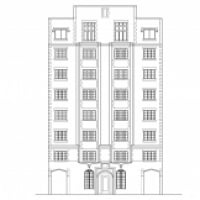What is this radiator cover insulated with?
Is that really what is shown in the picture below? If so, should I do anything about it? If every other steam-heated house has had these in there for the past 80 years, the numbers suggest this is not a particularly imminent threat. If, on the other hand, this is unusual, I can't really say that for sure.

Comments
-
PS: I think I posted this in the wrong category; my apologies.0
-
I think I would be more annoyed someone insulated the heat emitter.
Looks like some kind of old foam product to me.0 -
-
I thought that too, but it doesn't seem dense enough for cork. A lot of "holes" there.ChicagoCooperator said:Isn't that cork?
0 -
-
My first thought was also cork. I've been googling for "asbestos radiator cover" and there's not a lot. This is in northern NJ. House was built in 1923, but I have no particular reason to believe that the radiator covers are original (or that they are not).0
-
KC_Jones, any idea what they might have used to make foam back in the day?KC_Jones said:Looks like some kind of old foam product to me.
I might send this crud in to an asbestos lab. I did that once for some sketchy fireblock in my utility room. It turned out not to be asbestos, which gave me peace of mind as I insulated my boiler.
0 -
Does the box have any plywood in it...not around in 1923.
Same for Philips head screws.0 -
-
Is there any rationale for having it there, aside from making it more comfortable for my cat?0
-
-
I think cork, put there so things that could be damaged by heat could be placed on the rad cover (plants, candles, etc.).0
-
Covered Radiator With a radiator cover lined with foil insulation, you can reflect the radiant heat away from the exterior wall, and throw it further into the room.0
-
Just wondering where in New Jersey ,it may have been the same home where I had seen your basement radiator ,if so I think we replaced the boiler maybe 10 years ago or so maybe longer ? Peace and good luck clammy
R.A. Calmbacher L.L.C. HVAC
NJ Master HVAC Lic.
Mahwah, NJ
Specializing in steam and hydronic heating0 -
That's Cork. Seen it in old walk ins from the 60'sdavid_and_heather said:The other day, my electrician was helping me move a radiator cover so that we could access the wall behind it. He expressed a hypothesis that I did not like: this radiator cover, and all my other radiator covers, had a big fat slab of asbestos on top.
Is that really what is shown in the picture below? If so, should I do anything about it? If every other steam-heated house has had these in there for the past 80 years, the numbers suggest this is not a particularly imminent threat. If, on the other hand, this is unusual, I can't really say that for sure. 1
1 -
Cork. Sold for pushpin bulletin boards. I had some in my room in the 70s. See:
www.pinterest.com/pin/330522060122917227
Possibly to reduce oversized EDR.
It's a great way to get the EDR to what it should be with today's insulation, better windows, and closed windows (!)
If you don't want to replace the radiators, just cover some of them up and then get a boiler sized to the newly-reduced EDRNJ Steam Homeowner.
Free NJ and remote steam advice: https://heatinghelp.com/find-a-contractor/detail/new-jersey-steam-help/
See my sight glass boiler videos: https://bit.ly/3sZW1el0 -
It must be cork. Nothing else looks like that.
Radiator covers are nice because you get the mass of the full EDR for less swing between cycles, but it reduces the actually heating output.
A previous home I owned had them on every radiator. The home must have had over 800 EDR installed... on a home that needed 70k at design with good storm windows and dense multilayer plaster/bead board/shiplap/stucco wall assembly with a 4” air gap. Steam system had already been torn out. I can’t imagine how it would have cooked it. Gas line was 1-1/4”.0
Categories
- All Categories
- 87.3K THE MAIN WALL
- 3.2K A-C, Heat Pumps & Refrigeration
- 61 Biomass
- 429 Carbon Monoxide Awareness
- 120 Chimneys & Flues
- 2.1K Domestic Hot Water
- 5.8K Gas Heating
- 115 Geothermal
- 166 Indoor-Air Quality
- 3.7K Oil Heating
- 77 Pipe Deterioration
- 1K Plumbing
- 6.5K Radiant Heating
- 395 Solar
- 15.7K Strictly Steam
- 3.4K Thermostats and Controls
- 56 Water Quality
- 51 Industry Classes
- 50 Job Opportunities
- 18 Recall Announcements




